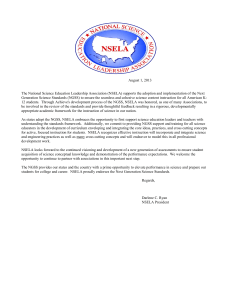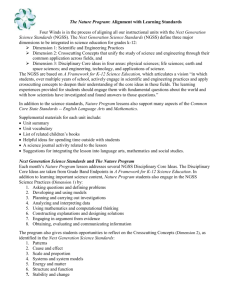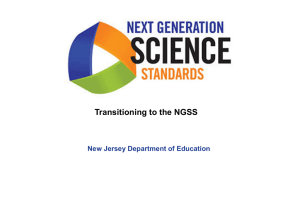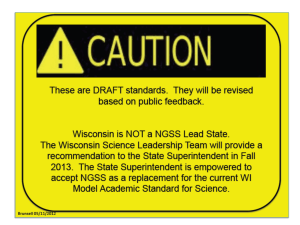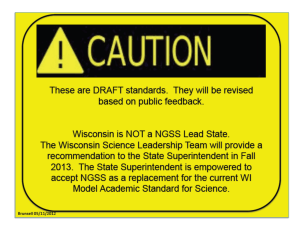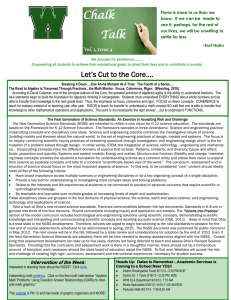Next Generation Science Standards
advertisement
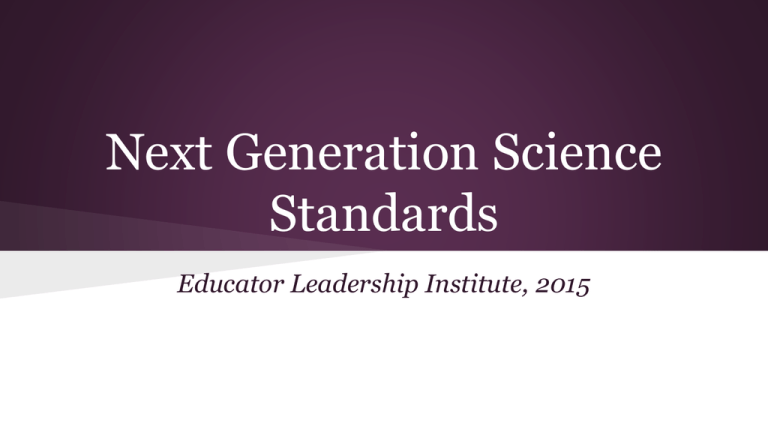
Next Generation Science Standards Educator Leadership Institute, 2015 Introductions Carol Baker - carolkeenebaker@gmail.com Jennifer Smith - smije@sages.us Mary Wirth - mwirth@sparta.k12.il.us Your Turn ● Name ● How NGSS impacts you ● Where you are in understanding/implementing NGSS ● A question/comment/concern about NGSS NGSS - Background ● Based on the Framework for K-12 Science Education developed by the National Research Council ● Developed by a 40 member writing team from 26 lead state partners ● Two public draft comment periods ● Fidelity review by NRC ● Completed April 2013 o Illinois adopted February 2014 - Now called New Illinois Learning Standards - Science (NILS-Science) Conceptual Shifts in the NGSS 1. K-12 Science Education Should Reflect the Interconnected Nature of Science as it is Practiced and Experienced in the Real World. 2. The Next Generation Science Standards are student performance expectations – NOT curriculum. 3. The Science Concepts in the NGSS Build Coherently from K-12. 4. The NGSS Focus on Deeper Understanding of Content as well as Application of Content. 5. Science and Engineering are Integrated in the NGSS from K–12. 6. The NGSS are designed to prepare students for college, career, and citizenship. 7. The NGSS and Common Core State Standards (English Language Arts and Mathematics) are aligned Three-Dimensional Learning What are Science and Engineering Practices? Practices are the behaviors that scientists engage in as they investigate and build models and theories about the natural world and the key set of engineering practices that engineers use as they design and build models and systems. Science and Engineering Practices 1. Asking questions (for science) and defining problems (for engineering) 2. Developing and using models 3. Planning and carrying out investigations 4. Analyzing and interpreting data 5. Using mathematics and computational thinking 6. Constructing explanations (for science) and designing solutions (for engineering) 7. Engaging in argument from evidence 8. Obtaining, evaluating, and communicating information What are Crosscutting Concepts? Crosscutting concepts are concepts that have application across all disciplines of science. As such, they provide a way of linking the different disciplines of science. Crosscutting Concepts 1. Patterns 2. Cause and effect: Mechanism and explanation 3. Scale, proportion, and quantity 4. Systems and system models 5. Energy and matter: Flows, cycles, and conservation 6. Structure and function 7. Stability and change What are Disciplinary Core Ideas? Disciplinary core ideas are the big ideas of science that provide scientists and engineers with the concepts and foundations to make sense of phenomena and/or design solutions to problems. Disciplinary Core Ideas ● ● ● ● Physical Sciences Life Sciences Earth and Space Sciences Engineering, Technology, and Applications of Science o Embedded in the other DCIs What are the core ideas in…? ● Matter and Its Interaction Physical Science ● Motion and Stability: Forces and Interactions ● Energy ● Waves and Their Applications in Technologies for Information Transfer What are the Core Ideas in…? ● From Molecules to Organisms: Structures and Processes Life Sciences ● Ecosystems: Interactions, Energy, and Dynamics ● Heredity: Inheritance and Variation of Traits ● Biological Evolution: Unity and Diversity What are the Core Ideas in…? ● Earth’s Place in the Universe Earth and Space Sciences ● Earth’s Systems ● Earth and Human Activity What are the Core Ideas in…? Engineering, Technology, and Applications of Science ● Engineering Design ● Links Among Engineering, Technology, Science, and Society An Analogy Three-Dimensional Learning is like making a really great meal. ● The cooking techniques are the practices. ● The main ingredients are the core ideas. ● The herbs and spices are the crosscutting concepts. Create Your Own Analogy Three-Dimensional Learning is like _________. ● Where ________ are the Practices; ● ________ are the Core Ideas; and ● ________ are the Crosscutting Concepts. Navigating the Standards Scavenger Hunt How many performance expectations are there? How many performance expectations also meet the Engineering DCI (have an engineering connection)? Which crosscutting concepts are associated with this standard? Which scientific practices are associated with this standard? Find one CCSS connection in ELA and one in math. Life Science Progression Model Course Mapping Conceptual Progressions Model (6-8 and 9-12) — the 6-8 and 9-12 grade band PEs are organized so that student understanding of concepts is built progressively throughout the course sequence. This model maps PEs into courses based on what concepts are needed for support without focusing on keeping disciplines separate. Science Domains Model (6-8 and 9-12) — the 6-8 and 9-12 grade band PEs are organized into content-specific courses that match the three science domains of the Framework: Physical Science, Life Science, and Earth Science. Since the Engineering domain is integrated into the other three in the NGSS, it was not separated out. Modified Science Domains Model (9-12) — the 9-12 grade band performance expectations are organized into content-specific courses that do not match the domains of the Framework, but rather match a common high school course sequence of biology, chemistry, and physics. New! Evidence Statements K-5 6-8 Highschool Questions? After looking at some of the standards, what questions do you have? Group Discussion Rotate through different stations in a group of your choice Answer questions on post-it notes to place on chart paper Place new questions on the Question Board We will come back together as a group to share our thoughts Resources NGSS Resource List - http://www.nextgenscience.org/resources This website includes EQuIP rubrics, evidence statements, and classroom sample tasks. The Concord Consortium - http://concord.org/ This website includes a pathfinder tool allowing users to select the core idea, scientific practice, and crosscutting concepts to cover and the pathfinder tool provides a list of online interactives that can be used to address the standards. Colleagues Others?


